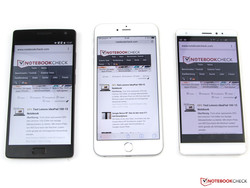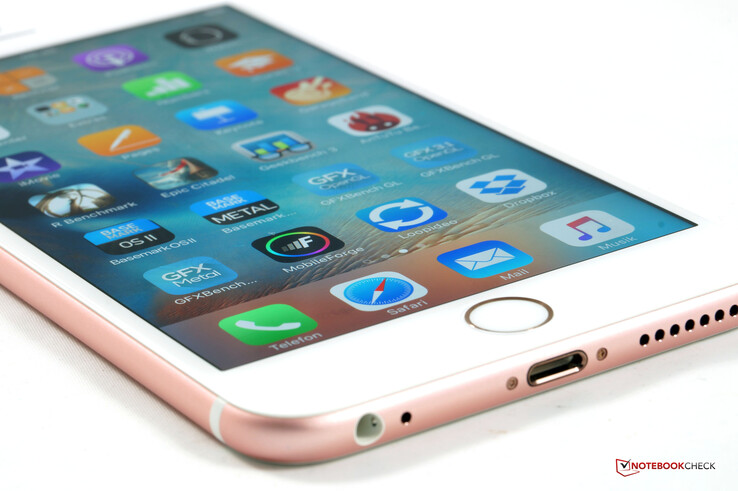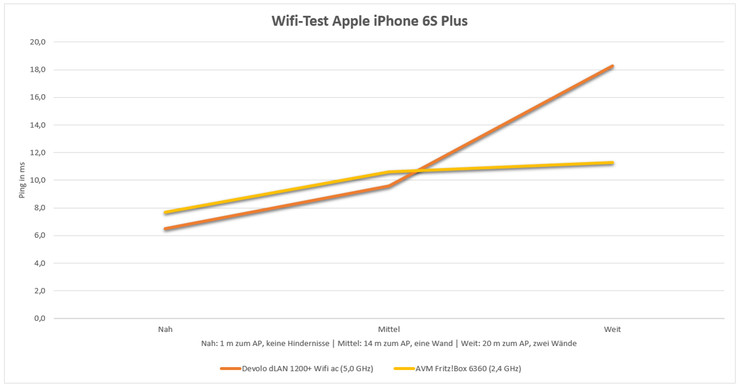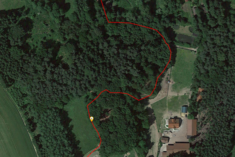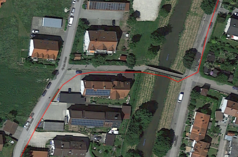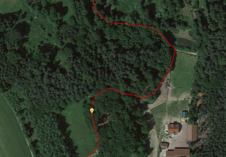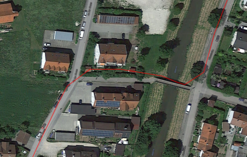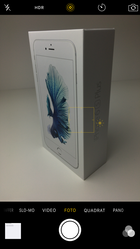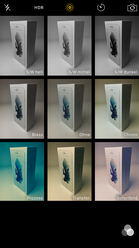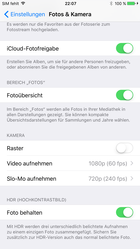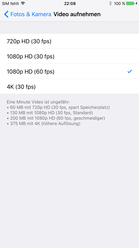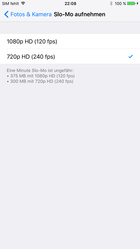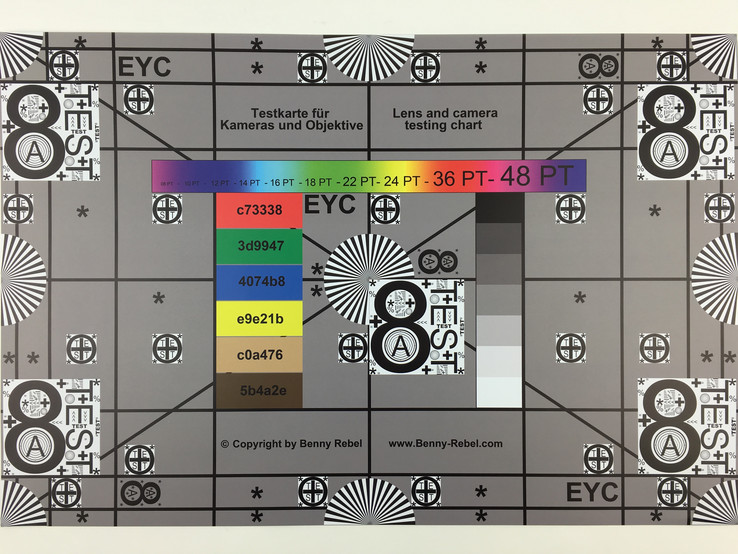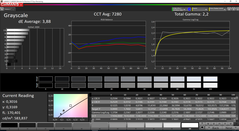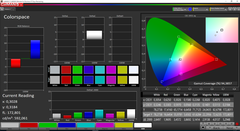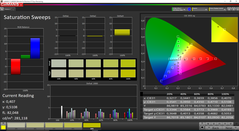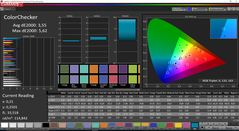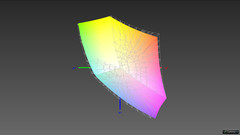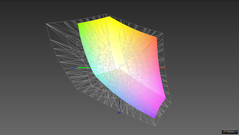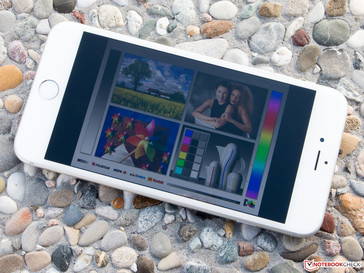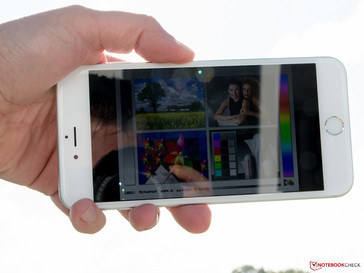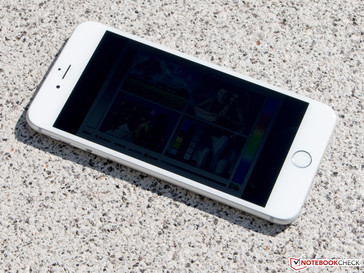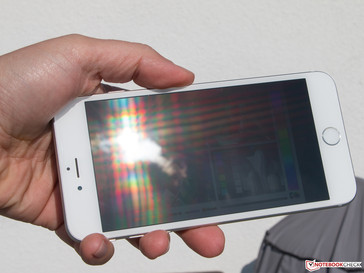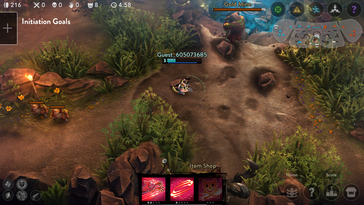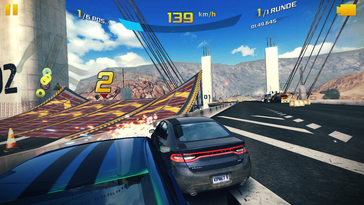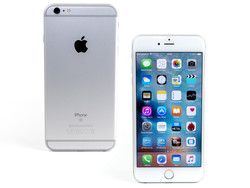Apple iPhone 6S Plus Smartphone Review
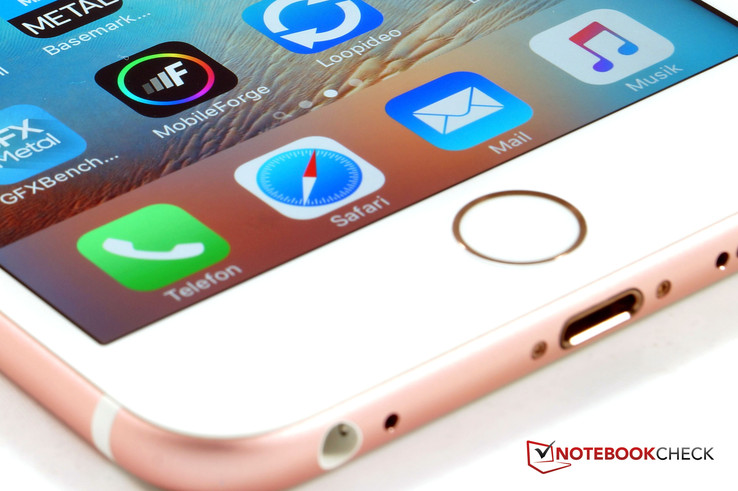
For the original German review, see here.
Our recent preview of the new iPhones already showed that Apple once again increased the performance and is on the best way to offer one of the best smartphones in general. It is certainly one of the most expensive: The iPhone 6S Plus retails for at least 850 Euros (~$958), and this is for the 16 GB version. Our review unit with 64 GB costs 960 Euros (~$1082), while the top model with 128 GB easily surpasses the 1,000-Euro mark (~$1127). Apple charges 1,070 Euros (~$1206), which is actually one difference compared with the old model: The iPhone 6S Plus is between 50 and 70 Euros (~$56 and ~$78) more expensive than its predecessor.
The price is, fortunately, not the only thing that changed. It is almost a tradition that Apple improves the components of the S models, while the chassis remains unchanged. The iPhone 6S Plus, however, is a bit different, because the Americans increased both the dimensions as well as the weight a bit, and Apple now uses more robust materials. The manufacturer also claims to have improved the cameras, the wireless communication modules and – perhaps the highlight of the new S model – the handling concept. The new iPhone generation also comes with a major iOS update, which offers many new features and handling possibilities in combination with the 3D Touch technology.
It is the first time that an iPhone is available in four different colors. In addition to the familiar colors Space Grey, Silver and Gold, you now get the version Rose Gold.
Case
The new iPhones are thicker, wider and longer, but the changes are very small so you will hardly notice them. The height is only increased by 0.2 millimeters for a total of 7.3 millimeters (8.1 millimeters including the camera). One thing you do notice in a direct comparison is the higher weight, because the iPhone 6S Plus is now 20 grams heavier than before. This means the 5.5-inch iPhone 6S Plus is one of the heaviest smartphones on the market, even though the predecessor was not really a featherweight, either. A similarly sized LG G4 is almost 40 grams lighter and is also much more compact. The main reason for the additional weight is the necessary technology for 3D Touch, which includes capacitive sensors in the illumination layer as well as the vibration generator called Taptic Engine. It creates a tactile feedback, which is, among others, used for the new touch features Peek and Pop.
Apple now uses 7000 series aluminum for the unibody construction, which is also supposed to be used in the aerospace sector. It is ultimately an aluminum alloy with zinc as a main alloy element. The aerospace sector is just one of many fields of application for 7000 series aluminum. Sport devices, bicycles and airplanes in particular, use this alloy. It is characterized by a very high strength of 220 up to 700 Nm/mm² depending on the composition of the alloy. The Ion-X-glass at the front is also supposed to be much more robust than before. Apple even claims it is the strongest glass in the smartphone sector. The development was necessary when we look at our 12-month old iPhone 6. There are numerous scratches on the display and we can see clear signs of wear at the back as well. We still have an iPhone 5 in our editorial office, which is three years old and looks almost new in comparison. By the way, a quick bending test was not an issue for the iPhone 6S Plus. If you bend the new iPhone, then it is on purpose. However, apart from the materials, the weight and the dimensions, there are no changes. The design of the new generation is identical to the predecessors.
Connectivity
It is a tradition that Apple uses new SoCs for its new smartphones, and this does not change with the current iPhone 6S Plus. Apple wants to raise the performance bar with the A9 chip and promises a performance gain of 70% for the CPU part and 90% for the GPU part. The latter is probably an Imagination PowerVR GT7600, which consists of six clusters and should be the fastest smartphone GPU right now. Thanks to the 14 and 16 nm manufacturing process, respectively, the A9 chip should also be the most power-efficient chip on the market. In addition to the new SoC, Apple also doubled the amount of RAM from 1 to 2 GB for the current iPhone generation.
Apple still keeps the storage configurations, which means the entry-level model is still the 16 GB version. As always, you cannot expand the storage of the Apple smartphone, so you should probably get the 64 GB model. Video enthusiasts that like to record in UHD can hardly avoid the 128 GB model.
Apple still uses its proprietary Lightning port for its mobile devices, which is just as comfortable to use as USB Type-C, but still proprietary. Lightning is also still limited to USB 2.0. In return, you get a lot of adaptors, which can be used to attach an external display or a memory card, for example.
Software
Now it really starts! If you still think that the new iPhones are faster and more expensive, but nothing else changed, then you might reconsider that after this section. iOS 9 has already been available for a couple of days – the first Apple device that was shipped with iOS 9 was the iPad Mini 4 – but the new iPhones also get a new control concept. From now on it is not only called Tap and Pinch anymore, but also Peek and Pop. These are Apple’s names for the new input methods that can be triggered by pushing on the display with different levels of force. Apple calls this 3D Touch. The touchscreen of the iPhone 6S Plus not only recognizes just taps and swipes, it can also differentiate between light and heavy pressure. Apps that are already adjusted to 3D Touch show a different behavior on the home screen. Pressing on an app symbol will open a kind of context menu – Quick Actions – that already offers some direct access functions. It is, for example, possible to open the search or display the latest pictures when you push down the Photos app. The Peek function, light pressure on the screen, gives you a preview for a link in Mail, for instance. More pressure – Pop – will then open the website in Safari. The new Live Photos, which "transforms" the picture into a small video sequence, also benefits from the Peek function. The number of apps with support for 3D Touch was increased during the review. We did not want to waive the new control concept after a couple of days.
Apple’s personal assistant Siri also got a small update and can now listen all the time if you want. It is possible to activate Siri directly with the command "Hey Siri!" so it can get the corresponding voice commands, even when the iPhone 6S Plus is in standby. Voice commands make much more sense like this. At first, Siri has to learn the voice of the user, so the wrong smartphone is not accidentally activated or multiple devices react to one voice command at the same time. We also tried it, and the voice differentiation worked very well during our test. Not many apps can be executed when the display is locked, but calls are possible, for example. Even the entry of a phone number worked without problems. This means you always have your hands free and can keep your eyes on the road when you are driving a car. Siri can also inform you about appointments. Unfortunately, it is not possible to start the navigation from standby, because the device has to be unlocked first. It is still a nice feature that Siri can now be active permanently.
Another new feature of iOS 9 is the energy-saving mode. We already mentioned the new menu item "Battery" in our review of the Apple iPad Mini 4. The option energy-saving mode, however, is reserved for the smartphones. It can be activated manually – via switch or Siri voice command. The system also asks you if it should activate the energy-saving mode when the battery capacity drops below 20%. It will deactivate some background processes, the brightness is slightly dimmed and the processor is throttled. The standby mode is also activated after 30 seconds. Subjectively, the battery lasts a bit longer with the activated energy-saving mode; especially the last 20% is pretty persistent. The energy-saving mode hardly affects the normal use, but push mails from IMAP4 accounts do not work, for example. Some users on the web report stutters, but we cannot confirm that. So should you just let the energy-saving mode stay activated all the time? It would be an idea, but it does not work. It is already deactivated as soon as the iPhone 6S Plus is charged and reached a battery capacity of at least 80%.
Not available on the new iPhones are the new multitasking functions of iOS. The display of the iPhone 6S Plus in particular would be large enough to use Slide Over, for instance. Apple divides the screen area in a 2:1 ratio, so copy & paste between two apps is easier. Apple's A9 is certainly powerful enough for multitasking.
Communication & GPS
Apple has also updated the communication modules. The 4G module now supports LTE Advanced Cat. 6 with 23 bands and a theoretical transfer rate of up to 300 Mbps (downstream). The Wi-Fi module is also slightly improved and now reaches up to 866 Mbps thanks to the MIMO technology. Bluetooth is fully up to date with version 4.2, and NFC is still not usable for third-party apps.
Unfortunately, it is not possible to read out the dampening of the Wi-Fi signals on the iPhones, so we took a closer look at the ping times of the iPhone 6S Plus instead. We logged it over a couple of minutes and then calculated an average result. We were able to measure pretty constant ping times at a short and medium distance in a 5 GHz network, which were always under 12 milliseconds (ms). They were similar when we moved away from the access point (AP), but showed occasional outliers at up to 27 ms. The signal quality was still good, so there are no serious restrictions and an HD video stream (720p) still ran smoothly. The fluctuations are a bit bigger in a 2.4 GHz network, and the signal quality already started to drop at a medium distance to the router. Still, we did not notice any serious restrictions, only the loading of websites was slightly delayed. All in all, a great Wi-Fi performance by the iPhone 6S Plus.
The quality of the Bluetooth connection was also very good during the review period. Audio streaming was no problem and there were no dropouts. The range of the connection is decent; there were no issues even with a wall between the smartphone and the receiver. However, Huawei's Mate S performed even better in this scenario.
Similar to the review of the Apple iPad Mini 4, the GPS module of the iPhone 6S Plus can completely convince us. It finds the satellites within a couple of seconds and could even locate the position indoors when we were close to a window. We compare the smartphone with our reference navigation device, a Garmin Edge 500, on a 7 km bicycle ride…and the latter actually loses the comparison. The GPS module inside the iPhone 6S Plus is a bit more precise in general and hardly takes any shortcuts even in narrow turns, so the overall distance is actually a bit longer than on the special navigation device. This means the iPhone is not only suited for navigation on roads or tracks, but it also works well for geo caching or MTB single trails.
Telephone & Voice Quality
The impression of the Apple iPhone 6S Plus is mixed in terms of calling. We usually understood the other person very well, but he could not confirm that on his side. The voice quality is actually decent, but the microphone of the iPhone could record voices more naturally. We would have expected more from a premium smartphone; especially the noise suppression cannot filter out all the ambient noise.
The speaker of the smartphone works pretty well as long the environment is very quiet. The voice of the iPhone user sounds tinny and a bit distorted in general. Background noises are not filtered out, so it was not possible to understand our voice at all when there was some slightly louder background music.
Cameras
Apple put a lot of work into the cameras and increased the resolution of both sensors. The old 1.2 MP front camera of the predecessor was finally replaced by a more modern 5 MP unit (1932x2576 pixels). It seems that selfies are now important besides FaceTime. The camera can also record videos in Full HD and has an automatic HDR mode. The pictures are comparatively good. The display can be used as a flash, which does not really help all that much in low-light situations, but it does at least reduce the shadows in the face a bit. There is no special Beauty mode.
The main camera now has a 12 MP sensor (4032x3024 pixels), which corresponds with an increase by 50%. This is still not really high, but the resolution is not all that counts. Apple also claims to have improved the technology. Unfortunately, it was not enough to reduce the height, because the camera still protrudes from the back by 0.8 millimeters.
It takes comparatively good pictures in return. We compared the HDR settings of the rivals in the first scene. The result of the iPhone 6S Plus looks pretty dark and shows a slightly low dynamic range. Both the Xperia Z3+ and especially the OnePlus 2 are much better. However, you notice that the picture of the iPhone is much sharper when you zoom in. The HDR object of the Sony smartphone on the other hand looks almost blurry in comparison, and the OnePlus 2 shows relief style structures. We would have liked to see a brighter lower half of the picture for our review unit.
The second scene is a close-up in the shade. The iPhone manages a very sharp image, but it is too cold. The blue cast is pretty noticeable and is even more apparent when you compare it with the picture of the OnePlus 2, which chooses a very warm white balance.
We took the third comparison shot in a dimmed environment, which is a tough task for the sensors. The iPhone 6S Plus certainly benefits a bit from its optical image stabilizer and performs similar to the Xperia Z3+, but it has a better white balance. It seems to be too dark for the OnePlus 2. The picture is brightened pretty well, but this does affect the picture quality and you can only see blurry contours.
All in all, the pictures of the iPhone 6S Plus are very good, but they can neither compete with the predecessor nor the Samsung Galaxy S6 (Edge) or LG G4 in terms of sharpness. Still, this is criticism on a very high level.
One aspect that should definitely be improved as soon as possible is the settings of the camera. You can only choose between the different camera modes within the app and control the flash, Live Photos and HDR. There is no manual mode and you also have to leave the app to change the settings when you record a video, because the resolution and the fps number can only be changed in the Settings.
The mentioned Live Photos was introduced as the next big camera feature during the presentation of the new iPhones. This is only a simple evolution of the moving pictures that we already know from the Nokia Lumia 930. The only difference is that Apple's implementation records 1.5 seconds before and after the actual image, while the Lumia only does it before you take the picture. One drawback is that you can only watch these Live Photos on the iPhone.
The iPhone 6S Plus offers quite a lot when you want to take a video, and it is finally possible to shoot in Ultra HD (3840x2160 pixels, 30 fps, around 49.8 Mbps). It is also possible to record Full HD videos at 30 or 60 frames per second. Time-lapses are possible, just like slow-motions. The latter can either be recorded at 120 (1080p) or 240 (720p) fps. The picture quality is comparatively good, and we preferred the videos in 1080p at 60 fps. The picture is smooth as expected, and it also stays sharp when you turn the camera quickly. The sound is at least recorded in stereo, but the quality is just average. It is also possible to take pictures (8 MP) during Ultra HD recordings. This is a nice feature, but we already know it from other smartphones. The Lumia 930 in particular offers even more features. The sound is not only recorded in HD audio and surround, but it is even possible to save every picture as an individual shot during UHD recordings.
Color Accuracy & Sharpness
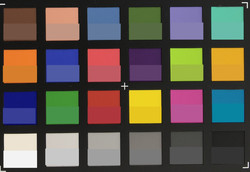
We took a picture of the ColorChecker Passport under controlled lighting conditions to analyze the color accuracy and compared it with other current smartphones. We used the automatic mode of the smartphones and compared and analyzed the pictures without any editing (no white balance afterwards). Both the iPhone 6S and 6S Plus can take the lead with the Sony Xperia Z3+ in terms of color accuracy. They are closely followed by the OnePlus 2 and then the Elephone P8000. The Honor 6+ and 7 and particularly the HTC One M9 delivered the worst results. Their color deviations were significant for all colors.
The new iPhones also leave a good impression in respect of the automatic exposure, and they are on par with the Xperia Z3+ and surprisingly also the Elephone P8000. The worst devices in our test were the HTC One M9 and Honor 7, which were almost a whole f-stop wrong.
The sensor (or the software, respectively) of the iPhone 6S Plus can convince in terms of color noise (pixel noise) as well. The noise level is surprisingly low at 0.6% compared to the rivals. Negative examples are the high MP sensors in the Sony Xperia Z3+ and the Honor 7.
ColorChecker |
iPhone 6s | iPhone 6s Plus | OnePlus 2 | Xperia Z3+ | One M9 | Honor 6+ | Honor 7 | Mate S | Elephone P8000 |
|---|---|---|---|---|---|---|---|---|---|
DeltaE 2000 |
5 | 5.4 | 6.1 | 5.1 | 14 | 9.4 | 8.9 | 8.6 | 7.6 |
Exposure Error (f-stops) |
-0.15 | -0,03 | 0.3 | -0.06 | -0.91 | 0.38 | 0.92 | 0.46 | -0.05 |
Pixel Noise max. (% from max. pixel level) |
0.51 | 0.61 | 0.68 | 1.51 | 0.68 | 1.28 | 1.9 | 0.6 | 1.44 |
We take a picture of the chart under defined artificial light for our sharpness test. We take a special look at the sharpness in the center, where the performance of the iPhone 6S and 6S Plus is good thanks to the higher resolution. The 20 MP sensor of the Z3Plus on the other hand shows even more details, but the OnePlus 2 and the Honor 7 do not have to hide, either. The Honor 7 and the Xperia Z3+ also produce by far the biggest files (7-8 MB vs. 2.5 MB for the iPhone, for example). Clearly beaten are the HTC M9 and Mate S. The Elephone P8000 also suffered from bad focusing.
Accessories
Smartphones are usually not shipped with many accessories, and the situation does not change when you buy a device from Apple. You get at least a usable in-ear headset with a remote that can also control the phone functions besides the usual power adaptor, the Lightning cable and the SIM tool.
You can buy a huge number of accessories in Apple’s online store. You will find pretty much anything you can imagine: covers, cases, bags, cables, headphones, stands and many more. Many of the products are also available in other online stores – often at much lower prices.
Warranty
The warranty is still a difficult topic for Apple, since it is one of the premium manufacturers that only grants a one-year warranty for its products. You can only extend this period with Apple Care+, which is actually more of an insurance and not a warranty extension. For a price of 149 Euros (~$167), Apple will repair two self inflicted damages within the two years for a service fee of 99 Euros (~$111) each. The classic warranty extension Apple Care Protection Plan on the other hand is only available for desktops, notebooks and displays from now on.
Input Devices & Handling
We wrote in the preview of this article: "The main focus of the optimized control concept of the new iPhones is 3D Touch. The touchscreen not only recognizes taps and swipe gestures, it now also recognizes pressure – in different intensities. Apple calls the corresponding actions Peek and Pop. Compatible apps also show some kind of context menu on the home screen. Apple calls this Quick Actions. You definitely have to get used to the new concept, but it does not take very long. We internalized the Quick Actions after a couple of hours, but we have to use the smartphone for a longer period for Peek and Pop – especially since there are even more new functions like pressing and swiping from the side, which can be used to switch between opened apps." After another five days, we can give you a better impression of 3D Touch: You also internalize Peek and Pop after a couple of days. We like to use it and do it often, especially for switching between apps and the quick actions. But 3D Touch also leaves room for improvement: We think it is very annoying that you always have to go through the menu when you want to select a Bluetooth device, which means the switching process between different Bluetooth devices was not improved. 3D Touch could easily solve this problem: Just press the Bluetooth icon in the Control Center and select the desired device from a list. We think this would be a nice feature.
Apple announced a significant improvement for the fingerprint scanner Touch ID, and we can confirm this necessary improvement. We always found the time between the scanning and the unlocking too long, and the sensor often had problems when the fingers were wet. The new Touch ID is really much faster and more reliable than the reader of the predecessors. The unlocking time is now certainly under a second. Freshly washed or sweaty hands do not create many errors anymore.
The virtual keyboard now shows small letters by default when you actually write in small letters. We think this is a good thing, but it can also be deactivated in the settings. We also liked the Trackpad function of the keyboard, which improves the navigation with the cursor significantly. This also works without 3D Touch. All in all, the handling is flawless thanks to a great touchscreen and the impeccable physical buttons. Nothing changed compared to the predecessor in this respect.
Display
There was hardly any new information about the display of the latest iPhone generation during the keynote. Because of this and a look at the specifications, it is probable that Apple did not change the panel. We were still able to determine slight improvements compared to the iPhone 6 Plus during the preview. This obviously does not change the key specs. Similar to the predecessor, you get a 5.5-inch IPS display with 1920x1080 pixels (FHD), which results in a pixel density of 401 PPI. We still think that Full HD is sufficient for smartphones, even though other manufacturers like Samsung or LG already use much higher resolutions.
Apple advertises a luminance of 500 cd/m², which is close to reality. Our measurements are even a bit better since we can determine a maximum luminance of 583 cd/m² and an average value of 560 cd/m² across nine measuring points. This is also a very good result in comparison with other high-end smartphones. The LG G4 is close to the iPhone 6S Plus, and the Sony Xperia Z3+ is even slightly brighter. The brightness distribution of the iPhone is also very good at 91%. The deviations are not visible to the human eye at any point.
The biggest improvement over the predecessor is the black value. While we measured 0.62 cd/m² for the iPhone 6 Plus, the value was now reduced to 0.46 cd/m² for the current iPhone. This is still far away from the absolute black of a Super-AMOLED display, but the resulting contrast ratio of 1267:1 meets the expectations for a flagship device.
| |||||||||||||||||||||||||
Brightness Distribution: 91 %
Center on Battery: 583 cd/m²
Contrast: 1267:1 (Black: 0.46 cd/m²)
ΔE ColorChecker Calman: 3.55 | ∀{0.5-29.43 Ø4.78}
ΔE Greyscale Calman: 3.88 | ∀{0.09-98 Ø5}
92.8% sRGB (Argyll 1.6.3 3D)
59.05% AdobeRGB 1998 (Argyll 1.6.3 3D)
Gamma: 2.2
CCT: 7280 K
| Apple iPhone 6S Plus A9 / PowerVR GT7600, A9, Apple AP0064K (iPhone NVMe) | Apple iPhone 6 Plus PowerVR GX6450, A8, 64 GB eMMC Flash | OnePlus 2 Adreno 430, 810 MSM8994, 64 GB eMMC Flash | LG G4 Adreno 418, 808 MSM8992, 32 GB eMMC Flash | Samsung Galaxy S6 Edge Mali-T760 MP8, Exynos 7420, 32 GB UFS 2.0 Flash | Huawei P8 Mali-T628 MP4, Kirin 930, 16 GB eMMC Flash | Sony Xperia Z3+ Adreno 430, 810 MSM8994, 32 GB eMMC Flash | |
|---|---|---|---|---|---|---|---|
| Screen | -13% | -1% | -15% | 8% | -2% | -35% | |
| Brightness middle (cd/m²) | 583 | 519 -11% | 451 -23% | 566 -3% | 343 -41% | 453 -22% | 605 4% |
| Brightness (cd/m²) | 560 | 496 -11% | 446 -20% | 536 -4% | 338 -40% | 439 -22% | 601 7% |
| Brightness Distribution (%) | 91 | 90 -1% | 90 -1% | 90 -1% | 94 3% | 91 0% | 92 1% |
| Black Level * (cd/m²) | 0.46 | 0.62 -35% | 0.3 35% | 0.47 -2% | 0.28 39% | 0.53 -15% | |
| Contrast (:1) | 1267 | 837 -34% | 1503 19% | 1204 -5% | 1618 28% | 1142 -10% | |
| Colorchecker dE 2000 * | 3.55 | 3.67 -3% | 3.84 -8% | 6.17 -74% | 2.2 38% | 4.7 -32% | 9.24 -160% |
| Greyscale dE 2000 * | 3.88 | 3.78 3% | 3.97 -2% | 6.26 -61% | 2.37 39% | 5.03 -30% | 10.01 -158% |
| Gamma | 2.2 100% | 2.42 91% | 2.46 89% | 2.48 89% | 2.41 91% | 2.27 97% | 2.22 99% |
| CCT | 7280 89% | 7327 89% | 7283 89% | 8171 80% | 6425 101% | 7439 87% | 10343 63% |
| Color Space (Percent of AdobeRGB 1998) (%) | 59.05 | 58.07 -2% | 65.48 11% | 87.77 49% | 72.04 22% | 65.65 11% | |
| Color Space (Percent of sRGB) (%) | 92.8 | 90.14 -3% | 98.63 6% | 97.1 5% |
* ... smaller is better
The good measurement results of the Apple iPhone 6S Plus are also convincing in practice. Black areas only appear a bit pale and gray at the highest luminance, but the display of the iPhone 6S Plus can convince with rich blacks at more realistic brightness settings. The colors are subjectively very good as well. Colors are vivid, but still pretty natural, which is also confirmed by the measurements with our colorimeter. The display does reveal a slightly increased color temperature in the grayscale that results in a visible blue cast for brighter shades, but this will be hardly visible in practice. Apple promises the full coverage of the sRGB color space, but the iPhone falls a bit short, even though the determined coverage of 92.8% is still a good result. The S6 models from Samsung, however, are better in this respect. There is hardly any criticism for the colors of the Apple iPhone. All the DeltaE values are in a good or even very good range, which results in an average deviation of 3.55. This means the iPhone 6S Plus is one of the best smartphones in this respect, only the S6 models from Samsung are once again better.
The Apple iPad Mini 4 already showed that you can still work comfortably under direct sunlight with a glossy display. The display of the iPhone 6S Plus on the other hand is not even close to this performance. It is very bright, which ensures a perfect visibility in the shade, but the visibility is clearly reduced under direct sunlight. However, the outdoor capabilities are still pretty good compared to other smartphones, but the new iPhone cannot keep up with the small iPad. We want to mention that the pictures were taken on a very bright and sunny day.
Close to perfection is the viewing-angle stability of the Apple iPhone 6S Plus: Colors remain stable from every direction, even from very flat angles. But the iPhone cannot avoid a slightly lowered brightness and therefore a lower contrast, either. Still, the flagship from Apple is really good in this area and is close to the S6 smartphones from Samsung.
Performance
The Californians show an impressive piece of technology with the Apple A9 SoC, which can sometimes easily beat the performance of the rivals. It is once again a 64-bit dual-core processor with a maximum clock of 1.84 GHz. According to Chipworks, the SoC is supposed to be provided by two CPU manufacturers: Samsung and TSMC. While Samsung (APL0898) uses a 14 nm architecture, TSMC (APL1022) produces the processor in 16 nm and it is slightly bigger than the Samsung model. The performance on the other hand is supposed to be identical and up to 60% higher compared to the predecessor. You also get 2 GB LPDDR4 memory for the first time.
There are not many specifications about the GPU from Apple. The manufacturer simply advertises a 90% higher performance. The GPUs are usually provided by Imagination, which will certainly provide its fastest component for Apple. It is very likely that the graphics unit belongs to the PowerVR-Series 7XT family. The fastest GPU from this series, the GT7600, would make sense. There are, however, no confirmations, so it is often just called Apple A9 GPU.
The benchmarks determine impressive results. Geekbench 3 shows that the iPhone 6S Plus manages the highest per-MHz performance, which is between 70 and 130% faster than the rivals. The iPhone SoC only uses two cores, so the situation can sometimes change in favor of the rivals that mainly use octa-core SoCs. Still, the 3DMark Unlimited Physics Test shows the enormous performance of the A9, only the Exynos 7420 inside the Galaxy S6 (Edge) is faster in this case.
The iPhone can also beat the rivals in the graphics benchmarks. It manages 20 up to 150% higher frame rates than all the other comparison devices in GFXBench Manhattan 3.0 (off-screen, OpenGL ES 3.0). This also includes the previous reference in respect of the gaming performance, the Nvidia Shield Tablet (Tegra K1). But even this device falls behind by 17%. The performance advantage of the iPhone is not that big when you use the OpenGL ES 2.0 interface, but it is still the fastest smartphone right now.
There is no criticism for the subjective performance impression. The operating system iOS 9.0.1 ran very smoothly during the review. However, we noticed some stutters during the switch to the home screen after we used the camera extensively or played games for a while.
| Geekbench 3 | |
| 64 Bit Single-Core Score (sort by value) | |
| Apple iPhone 6S Plus | |
| Samsung Galaxy S6 Edge | |
| LG G4 | |
| OnePlus 2 | |
| HTC One M9 | |
| Sony Xperia Z4 Tablet | |
| 64 Bit Multi-Core Score (sort by value) | |
| Apple iPhone 6S Plus | |
| Samsung Galaxy S6 Edge | |
| LG G4 | |
| OnePlus 2 | |
| HTC One M9 | |
| Sony Xperia Z4 Tablet | |
| AnTuTu v5 - Total Score (sort by value) | |
| Apple iPhone 6S Plus | |
| Apple iPhone 6 Plus | |
| Samsung Galaxy S6 Edge | |
| LG G4 | |
| OnePlus 2 | |
| HTC One M9 | |
| NVIDIA Shield Tablet LTE P1761 | |
| Sony Xperia Z4 Tablet | |
| GFXBench 3.0 | |
| on screen Manhattan Onscreen OGL (sort by value) | |
| Apple iPhone 6S Plus | |
| Apple iPhone 6 Plus | |
| Samsung Galaxy S6 Edge | |
| LG G4 | |
| OnePlus 2 | |
| HTC One M9 | |
| NVIDIA Shield Tablet LTE P1761 | |
| Sony Xperia Z4 Tablet | |
| 1920x1080 1080p Manhattan Offscreen (sort by value) | |
| Apple iPhone 6S Plus | |
| Apple iPhone 6 Plus | |
| Samsung Galaxy S6 Edge | |
| LG G4 | |
| OnePlus 2 | |
| HTC One M9 | |
| NVIDIA Shield Tablet LTE P1761 | |
| Sony Xperia Z4 Tablet | |
| 3DMark | |
| 1280x720 offscreen Ice Storm Unlimited Score (sort by value) | |
| Apple iPhone 6S Plus | |
| Apple iPhone 6 Plus | |
| Samsung Galaxy S6 Edge | |
| LG G4 | |
| OnePlus 2 | |
| HTC One M9 | |
| Sony Xperia Z4 Tablet | |
| 1280x720 offscreen Ice Storm Unlimited Graphics Score (sort by value) | |
| Apple iPhone 6S Plus | |
| Apple iPhone 6 Plus | |
| Samsung Galaxy S6 Edge | |
| LG G4 | |
| OnePlus 2 | |
| HTC One M9 | |
| Sony Xperia Z4 Tablet | |
| 1280x720 offscreen Ice Storm Unlimited Physics (sort by value) | |
| Apple iPhone 6S Plus | |
| Apple iPhone 6 Plus | |
| Samsung Galaxy S6 Edge | |
| LG G4 | |
| OnePlus 2 | |
| HTC One M9 | |
| Sony Xperia Z4 Tablet | |
| Basemark ES 3.1 / Metal - offscreen Overall Score (sort by value) | |
| Apple iPhone 6S Plus | |
| OnePlus 2 | |
| HTC One M9 | |
| NVIDIA Shield Tablet LTE P1761 | |
| Sony Xperia Z4 Tablet | |
The Safari browser is traditionally the fastest mobile software in a direct benchmark comparison. This does not change with the new generation and the advantage is pretty big. It is never a close decision in any benchmark; the iPhone is the reference and can easily beat the rivals. The subjective impression is convincing as well. Websites are quickly loaded and there are hardly any delays when you have a good Internet connection.
| Octane V2 - Total Score (sort by value) | |
| Apple iPhone 6S Plus | |
| Apple iPhone 6 Plus | |
| Samsung Galaxy S6 Edge | |
| LG G4 | |
| OnePlus 2 | |
| HTC One M9 | |
| Sony Xperia Z4 Tablet | |
| Sunspider - 1.0 Total Score (sort by value) | |
| Apple iPhone 6S Plus | |
| Apple iPhone 6 Plus | |
| Samsung Galaxy S6 Edge | |
| LG G4 | |
| OnePlus 2 | |
| HTC One M9 | |
| Sony Xperia Z4 Tablet | |
| JetStream 1.1 - Total Score (sort by value) | |
| Apple iPhone 6S Plus | |
| Samsung Galaxy S6 Edge | |
| LG G4 | |
| OnePlus 2 | |
| HTC One M9 | |
| Mozilla Kraken 1.1 - Total (sort by value) | |
| Apple iPhone 6S Plus | |
| Apple iPhone 6 Plus | |
| Samsung Galaxy S6 Edge | |
| LG G4 | |
| OnePlus 2 | |
| HTC One M9 | |
| Sony Xperia Z4 Tablet | |
| Peacekeeper - --- (sort by value) | |
| Apple iPhone 6S Plus | |
| Apple iPhone 6 Plus | |
| Samsung Galaxy S6 Edge | |
| LG G4 | |
| HTC One M9 | |
| Sony Xperia Z4 Tablet | |
| WebXPRT 2015 - Overall (sort by value) | |
| Apple iPhone 6S Plus | |
| LG G4 | |
| OnePlus 2 | |
| HTC One M9 | |
| NVIDIA Shield Tablet LTE P1761 | |
| Sony Xperia Z4 Tablet | |
* ... smaller is better
The iPhone 6S Plus is once again available with three storage configurations (16, 64 and 128 GB). It is still not possible to expand the storage via microSD card. Our review unit has 64 GB NVMe flash storage, and 51.4 GB can be used after the initial start. We think 16 GB is too small when you consider Ultra HD videos since the high resolution video standard needs 375 MB per minute. The additional charge of 110 Euros (~$124) is pretty steep, so some customers will certainly get the smaller model.
The performance of the new NVMe storage is supposed to be very high and also surpasses the UFS storage of the Galaxy S6 (Edge) according to our colleagues from AnandTech. The iPhone manages very good results in our benchmarks and can beat all rivals in PassMark. The situation changes in Basemark OS II, where the review unit is just average. However, you have to consider that the Memory result of this app is also influenced by other memory components and it does not only evaluate the read and write performance of the flash storage.
| BaseMark OS II - Memory (sort by value) | |
| Apple iPhone 6S Plus | |
| Apple iPhone 6 Plus | |
| Samsung Galaxy S6 Edge | |
| LG G4 | |
| OnePlus 2 | |
| HTC One M9 | |
| Sony Xperia Z4 Tablet | |
| PassMark PerformanceTest Mobile V1 - Disk Tests (sort by value) | |
| Apple iPhone 6S Plus | |
| Apple iPhone 6 Plus | |
| Samsung Galaxy S6 Edge | |
| LG G4 | |
| OnePlus 2 | |
| HTC One M9 | |
| Sony Xperia Z4 Tablet | |
Games
The panel size is much bigger compared to the smaller iPhone 6S. This is an advantage when you play games and the device also feels better in the hands, especially when you play racing games like Asphalt 8. Performance is no problem, and we never had the feeling that we would reach the limits of our review unit. This probably won’t change in the next couple of years.
The touchscreen, the sensors and the speaker complement the overall package very well. We cannot really criticize anything, only the position of the speaker is not perfect because it can be easily covered when you hold the smartphone in landscape mode.
Emissions
Temperature
The surface temperatures are a bit higher compared to the predecessor. The differences are still very small while idling and the Apple iPhone 6S Plus stays lukewarm at up to 37 °C. Still, the idle temperatures of the iPhone are much higher compared to the Samsung Galaxy S6 Edge, which stays under 30 °C at all measurement spots. This does not really change under maximum load: The new iPhone is once again warmer than its predecessor at 43.4 °C, and the Samsung S6 Edge is also much cooler. The power adaptor also gets much warmer compared to the rivals at up to 46 °C. Overall, the temperatures are still not in a critical area.
This does not necessarily mean that the components do not throttle because the temperatures inside the chassis are too high. We check that with the GFXBench Battery Test, which repeats the T-Rex benchmark thirty times. It usually logs the frame rates, clocks as well as the temperatures – but unfortunately not for iOS devices. Benchmarks (3DMark 2013 and BaseMark) run immediately after the Battery Test only show small deviations compared to the results with a cold smartphone. This means there is definitely no noteworthy or even perceptible throttling.
(±) The maximum temperature on the upper side is 41.3 °C / 106 F, compared to the average of 35.2 °C / 95 F, ranging from 21.9 to 247 °C for the class Smartphone.
(±) The bottom heats up to a maximum of 43.4 °C / 110 F, compared to the average of 34 °C / 93 F
(+) In idle usage, the average temperature for the upper side is 31.9 °C / 89 F, compared to the device average of 32.9 °C / 91 F.
Speakers
There is not much to say in this section, at least nothing new. The sound characteristics did not change compared to the old model. You once again get a mono speaker at the bottom edge of the chassis that reaches a pretty high maximum volume with usable medium and deep tones, but there is no perceptible bass. The high tones sound a bit fuzzy and the playback is a bit distorted and tinny at the highest volume. The provided in-ear headphones work pretty well.
Energy Management
Power Consumption
The capacity of the lithium-ion battery is now 10.45 Wh, which is 6% smaller compared to the predecessor. Apple still promises battery runtimes on par with the iPhone 6 Plus – despite the slightly brighter display and the much higher performance. This is possible due to the combination of the more efficient A9 chip as well as the latest version of the mobile operating system iOS 9. The power consumption is actually a bit lower than the predecessor in almost all scenarios. Only the maximum power consumption of the iPhone 6S Plus is a bit higher than the iPhone 6 Plus. Compared to the Samsung Galaxy S6 Edge, the iPhone particularly consumes more power under light workloads.
| Off / Standby | |
| Idle | |
| Load |
|
Key:
min: | |
Battery Runtime
The battery runtimes of the Apple iPhone 6S Plus are on par with the predecessor and even tend to be a bit better. The results of the new large iPhone are also very good within the comparison group in the two realistic video playback and Wi-Fi tests. We dim the luminance to 150 cd/m² in both scenarios and deactivate all communication modules – except for Wi-Fi in the browsing test. The browser opens a new website every 30 seconds, logs the elapsed time and uses a server-based script. The iPhone 6S Plus manages around eight-and-a-half hours, only the Samsung S6 Edge can keep up with that among the high-end competition. The other flagships are sometimes clearly beaten by the iPhone, which also applies for the playback of an H.264 Full HD video. The only difference is that the advantage of the 6S Plus is even bigger.
Sustained maximum load at the highest luminance and active communication modules, including Siri, only results in 03:17 hours for the iPhone 6S Plus, which is a bit shorter than the predecessor and almost every comparison device. The idle runtime of the big iPhone with the lowest brightness in the airplane mode is excellent: Our Wi-Fi reading script determines 27:35 hours. All in all, we can confirm Apple’s statement: The smaller battery does not affect the runtimes. Quite the contrary – the stamina is exemplary.
| Apple iPhone 6S Plus A9 / PowerVR GT7600, A9, Apple AP0064K (iPhone NVMe) | Apple iPhone 6 Plus PowerVR GX6450, A8, 64 GB eMMC Flash | OnePlus 2 Adreno 430, 810 MSM8994, 64 GB eMMC Flash | LG G4 Adreno 418, 808 MSM8992, 32 GB eMMC Flash | Samsung Galaxy S6 Edge Mali-T760 MP8, Exynos 7420, 32 GB UFS 2.0 Flash | Huawei P8 Mali-T628 MP4, Kirin 930, 16 GB eMMC Flash | Sony Xperia Z3+ Adreno 430, 810 MSM8994, 32 GB eMMC Flash | |
|---|---|---|---|---|---|---|---|
| Battery runtime | -3% | -11% | -36% | -9% | -8% | -3% | |
| H.264 (h) | 11.9 | 11.3 -5% | 9.7 -18% | 8.4 -29% | 7 -41% | 9.7 -18% | 8.8 -26% |
| WiFi v1.3 (h) | 8.6 | 5.9 -31% | 5.4 -37% | 8.9 3% | 7.2 -16% | 6.5 -24% | |
| Load (h) | 3.3 | 3.3 0% | 3.8 15% | 1.9 -42% | 3.7 12% | 3.6 9% | 4.7 42% |
| WiFi (h) | 13 |
Pros
Cons
Verdict
It was already indicated in the preview: The new Apple iPhone 6S Plus will noticeably raise the bar in respect of the processor and graphics performance. This assumption was confirmed in our in-depth review. The Apple A9 chip is currently the benchmark in the smartphone segment. All the high-end competitors are beaten in almost every test, and the graphics performance is so high that even the flagship devices from the competitors are pretty much outclassed. Another strength of the iPhones is still the browser performance. It is impressive what the new smartphones from Cupertino deliver in this respect. iOS 9 plays its part as well, which was confirmed by tests with older iOS devices.
The chassis of the iPhone 6S Plus is now much more stable and – hopefully – more resistant to scratches than its predecessor. There should be no problems with a Bendgate 2.0. That the S model is a bit thicker, longer and wider is not an issue in practice. The much higher weight on the other hand is noticeable, especially when you hold the device in one hand. Overall, the quality of the chassis is once again on a very high level. The design did not change, but that is a matter of taste anyway.
Apple also improved the communication modules: Latest Bluetooth, faster Wi-Fi and LTE modules certainly make the 6S generation more appealing. That NFC is still only available for Apple Pay…well, that’s Apple. This is also the case for the non-expandable storage.
All these things are well and good, but they do not justify an upgrade from the predecessor generation under reasonable aspects. The iPhone 6 Plus is still one of the most powerful smartphones on the market. The difference is – if at all – the new control concept 3D Touch. New functions and menus improve the handling in many areas, but iOS 9 and 3D Touch, respectively, are not completely bug-free. Live Photos is a nice feature, but the short sequences are only really good if you can film something beautiful. Live Photos does not add any value if you take a picture from a still object or an environment. Children and animals on the other hand are perfect. The picture quality on the other hand did not get a huge bump, at least in the case of the main camera. It still takes above-average shots and can now also record videos in 4K. Still, the new iPhone cannot keep up with real camera highlights like the S6 models from Samsung or the LG G4. We can, however, see improvements at the front, and the display flash is a good thing.
What's left to say? The battery runtimes are still on par with the predecessor or even slightly better, despite the smaller battery. The iPhone 6S Plus therefore still convinces with an above-average stamina among the high-end competition. If the battery capacity is running low, you can use the new energy-saving mode.
So, is the new Apple iPhone 6S Plus currently the best smartphone on the market? Not really. The S6 models from Samsung are still one step ahead of the new iPhone. The 6S Plus is still one of the best smartphones, and certainly the best iPhone; and the most expensive.
Apple iPhone 6S Plus
- 04/13/2016 v5 (old)
Daniel Schmidt, Patrick Afschar Kaboli




